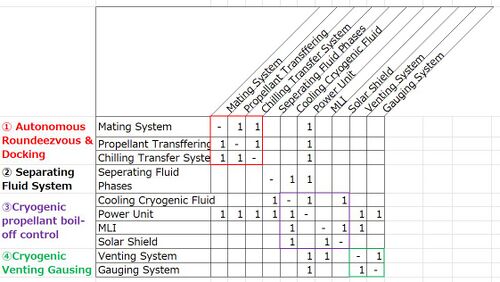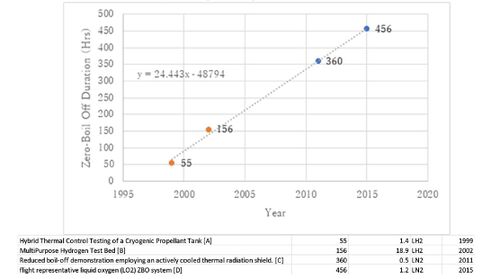In Space Propellant Depot
Roadmap Overview
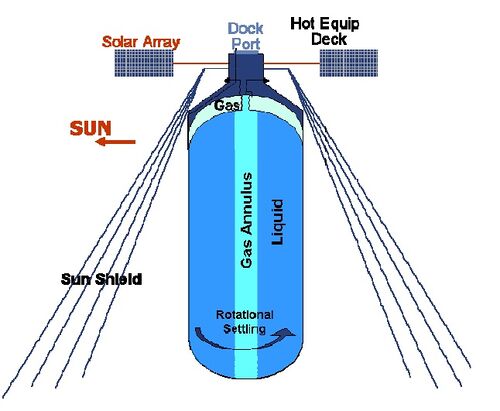 <ref> Kutter,B.F., et al. (2011, September, 9-11) A Practical, Affordable Cryogenic Propellant Depot Based on ULA’s Flight Experience</ref>
<ref> Kutter,B.F., et al. (2011, September, 9-11) A Practical, Affordable Cryogenic Propellant Depot Based on ULA’s Flight Experience</ref>
In the late 1800s James Dewar became famous for his study in the liquefaction of gases such as hydrogen and oxygen. Current Cryogenic storage containers are referred to as dewars. In the 1959 both LOX and LH2 were used to propel the second and third stages of the Saturn rocket. In 1966 LH2 and LOX were chosen to power the Atlas-Centaur rocket. “As early as 1928, scientists studying interplanetary travel began arguing that pre-positioning propellants in orbit would be required for any sustainable large-scale travel beyond Earth.” <ref>Goff Ja et al. “Realistic Near-Term Propellant Depots: Implementation of a Critical Spacefaring Capability” p 2 </ref>. In 2007 Boeing addressed the value of creating propellant depots to increase the payload one could carry to future moon missions <ref> Benioff, D. (2007, October, 1-5) LEO Propellant depot: A commercial opportunity </ref>. This idea was also brought up to Masten space systems in 2008 <ref>Goff, J. et al.(2008) The Case for Orbital Propellant Depots </ref> In 2010 ULA (United Launch Alliance), began to develop ACES (Advanced Cryogenic Evolved Stage) which was a high-performance upper stage rocket with the ability to store and transfer propellant to later missions. ULA also was working on creating CRYOTE (Cryogenic Orbital Testbed) to demonstrate the feasibility of cryogenic fluid management in micro and zero gravity <ref> Gravlee, M., et al. (2011) Cryogenic Orbital Testbed (CRYOTE) Development Status </ref>. In 2018 Vice President Pence at the 34th Space Symposium outlined the plan to have NASA return to the moon with the eventual use of a space depot. <ref> Pence, M.R. (2018, April, 16) Remarks by Vice President Pence at the 34th Space Symposium | Colorado Springs, CO </ref>. To date though there has been no space tested propellant depot.
Design Structure Matrix
Object Process Diagram
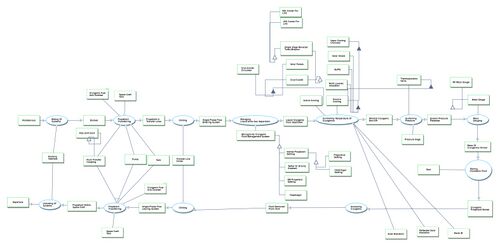
The above diagram shows the objects and processes required for an in-space propellant depot
In Space Propellant Depot Technology Roadmap
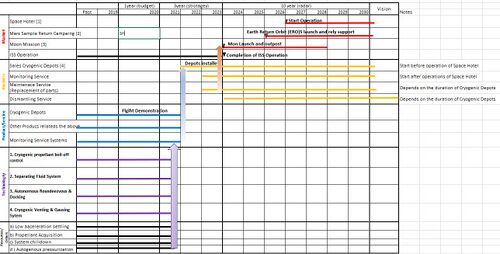
The above technology roadmap shows the roadmap to an in-space propellant depot based on the dates provided by the ULA for the centaur V rocket which should contain a type of in space propellant depot
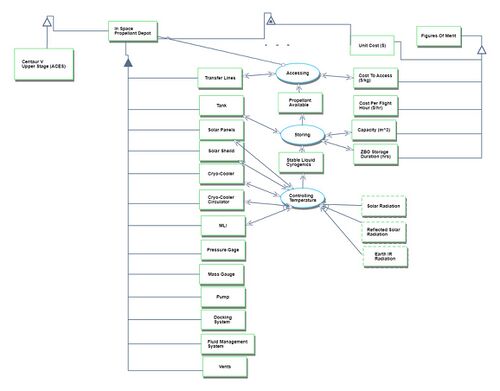
Figures of Merit
The FOMs are following:
● Duration of ZBO storage [days]
● Maximum Capacity [m^3]
● Unit Cost [$]
● Cost per hour(operational and maintenance [$/hr]
● Cost to attain per weight [$/kg]
The above graph shows data for the developed testbeds which did in fact reach Zero Boil-Off (Duration vs. Year). Albeit these are for different gases, the first two are LH2 and the second two are LN2 (simulating LOX). LH2 has to be stored below 20K and LOX needs to be stored below 90K. The methodology used for storage is the same (aside from the necessary temperature), so the progress in duration of sustained zero-boil-off is still relevant since the improvements for one could be used for the other. The dFOM/dt found is 24.4 hours ZBO/year.
For this specific FOM the theoretical limit is likely close to inifite, but once long term ZBO is attained there would be other figures of merit which would have limits. For example, the power necessary to sustain ZBO would have a limit based on the amount of power which could be generated by the solar panels and the structure to support them. Similarly, the capacity of the tanks would have limits based on the structural limitations and the force of gravity of the depot.
Were the testing on each of these done for longer duration there would be significant boil-off <ref> Chai,P.R., et al. (2013, December, 16) Cryogenic thermal system analysis for orbital propellant depot</ref>. A better predictive metric would be the % boil-off per month, but none of these tests were performed for a month or more. The current state of the FOM is slowly increasing but is limited by the cooling capacity of the cryocoolers currently available. Were the Fuel used to be liquid methane instead of LH2, the completion of the development of a 150W 90K cryocooler by Creare (being funded by NASA) <ref> Platcha, D. (2017, July, 7) NASA cryocooler technology developments and goals to achieve zero boil-off and to liquefy cryogenic propellants for space exploration </ref> would allow ZBO for a propellant depot containing LOX [7]. Methane has a higher boiling point, so it would likely be able to sustain ZBO as well. Both SpaceX and Blue Origin plan on using Methane/LOX powered rockets, so this may well be a useful and attainable technology in the near future.
